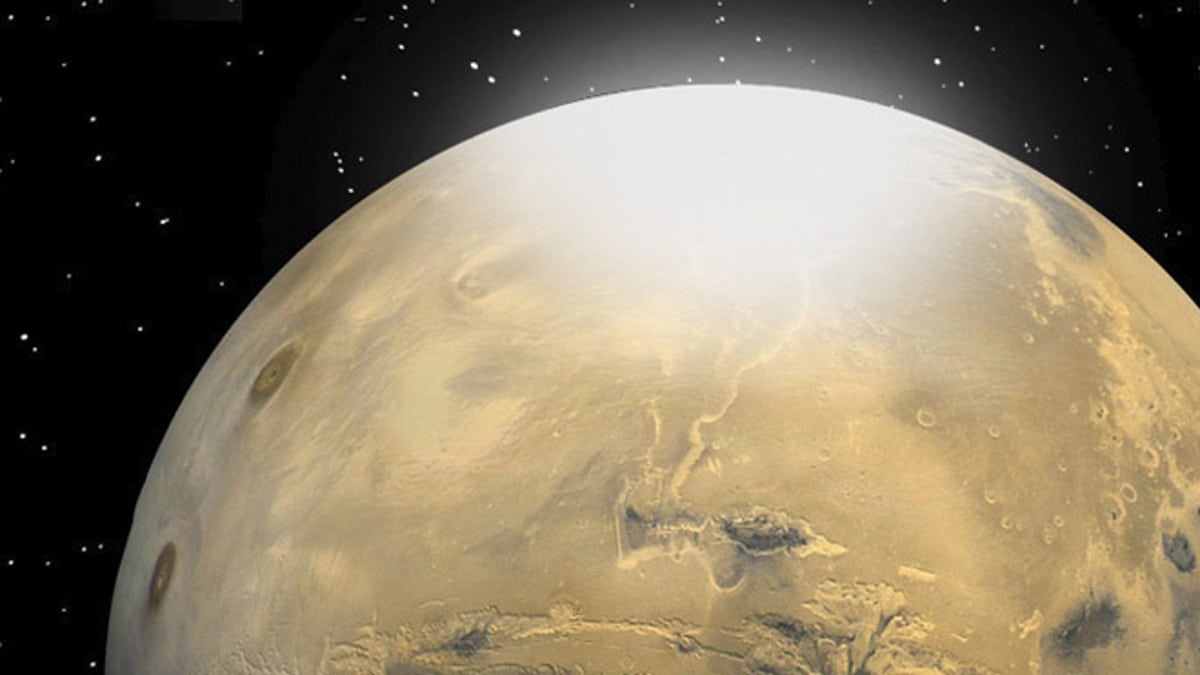
MIT has uncovered some rather interesting facts about Martian snow -- snow like nothing we can ever experience on Earth. (NASA, Christine Daniloff/MIT News)
Everyone seems to ponder the lyrics of Train's song "Drops of Jupiter," so perhaps it's about time a songwriter includes the "Snowflakes of Mars" in their next ballad. MIT scientists might be able to add prose to the lyrics by describing their study into the very alien snow that falls from Red Planet skies.
After collecting the vast quantities of data gathered by orbiting Mars spacecraft, the Massachusetts Institute of Technology team has uncovered some rather interesting facts about Martian snow.
But before you start dreaming about snowball fights and reindeer grazing on the slopes of Olympus Mons, think again -- this snow is like nothing we can ever experience on Earth.
PHOTOS: Weird (and Weirdly Familiar) Weather On Mars
For starters, as the majority of the Mars atmosphere is composed of carbon dioxide, the snowflakes are made from CO2 ice -- basically tiny particles of 'dry ice.' Also, the snowflakes are very small -- approximately the size of a red blood cell.
[pullquote]
"These are very fine particles, not big flakes,” said MIT assistant professor Kerri Cahoy in a press release. If you saw these 'snowflakes' fall, "you would probably see it as a fog, because they're so small," she added.
Using data from NASA's Mars Global Surveyor (MGS) and Mars Reconnaissance Orbiter (MRO), the team also found that the Martian snow buildup in the south arctic regions is 50 percent larger than the snowfall over north arctic regions. There are also seasonal variations -- during the winter, the CO2 snow clouds spread to very low latitudes, about half-way to the Martian equatorial regions (much like on Earth).
But how did the team manage to measure the quantity of snow over the Martian arctic regions in the first place? The researchers made an estimate based on seasonal gravitational variations as detected by satellites in orbit. The tiny fluctuations in Mars' gravitational field over the course of a year corresponded to the buildup of snow.
But they didn't stop there. With a good understanding of the atmospheric conditions and the mass of snowfall, graduate student Renyu Hu (and lead author of the paper published in the Journal of Geophysical Research) was able to get a handle of the size of CO2 ice particles locked in the snowfall. In the north, CO2 'snowflakes' measure 8 to 22 microns wide, whereas in the south, the particles measure between 4 to 13 microns wide.
Getting intimate with the characteristics of the CO2 snow is a testament to the detailed measurements that are continuously being made by the armada of satellites that orbit Mars.
"It’s neat to think that we've had spacecraft on or around Mars for over 10 years, and we have all these great datasets," Cahoy says. "If you put different pieces of them together, you can learn something new just from the data."
HOWSTUFFWORKS: Planet Storm: Mars Weather
Although understanding snowfall and snow cover reveals some wonderful science, this work will also help us understand the dust that is blown around the planet. For the CO2 ice crystals to form in the first place, they need something to condense around -- such as dust particles.
"What kinds of dust do you need to have this kind of condensation?" Hu asks. "Do you need tiny dust particles? Do you need a water coating around that dust to facilitate cloud formation?"
For me, only one more question remains: When will human eyes witness the first flurry of Martian 'snowflakes' as winter sets in during a manned expedition to the Red Planet? If this guy has anything to do with it, we may only be a couple of decades away.
